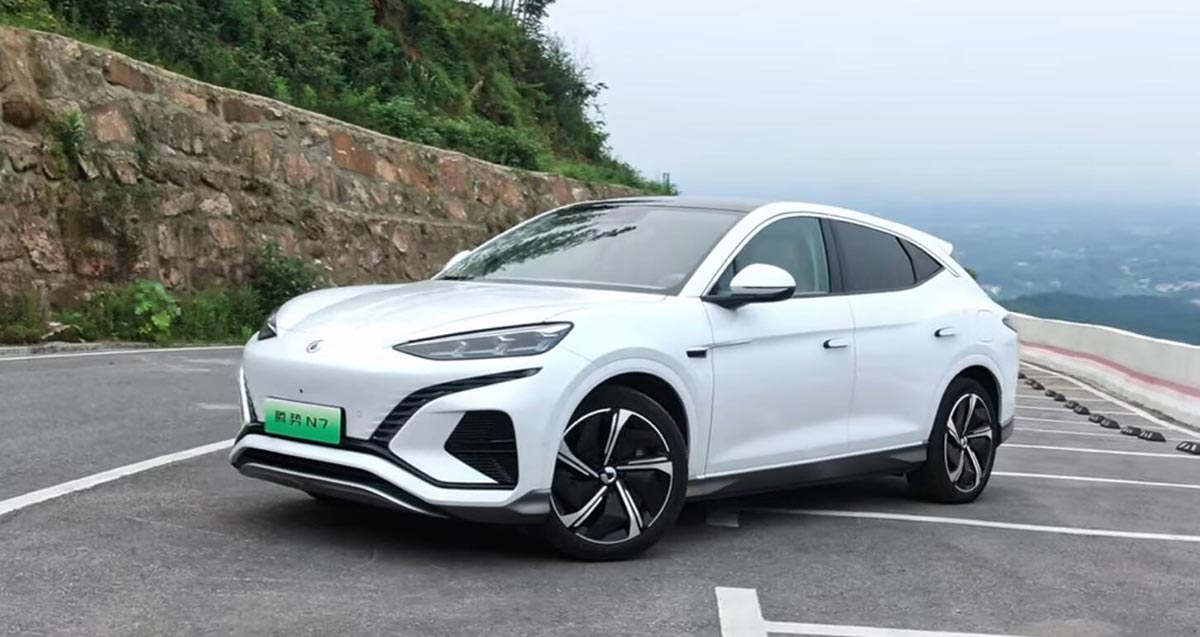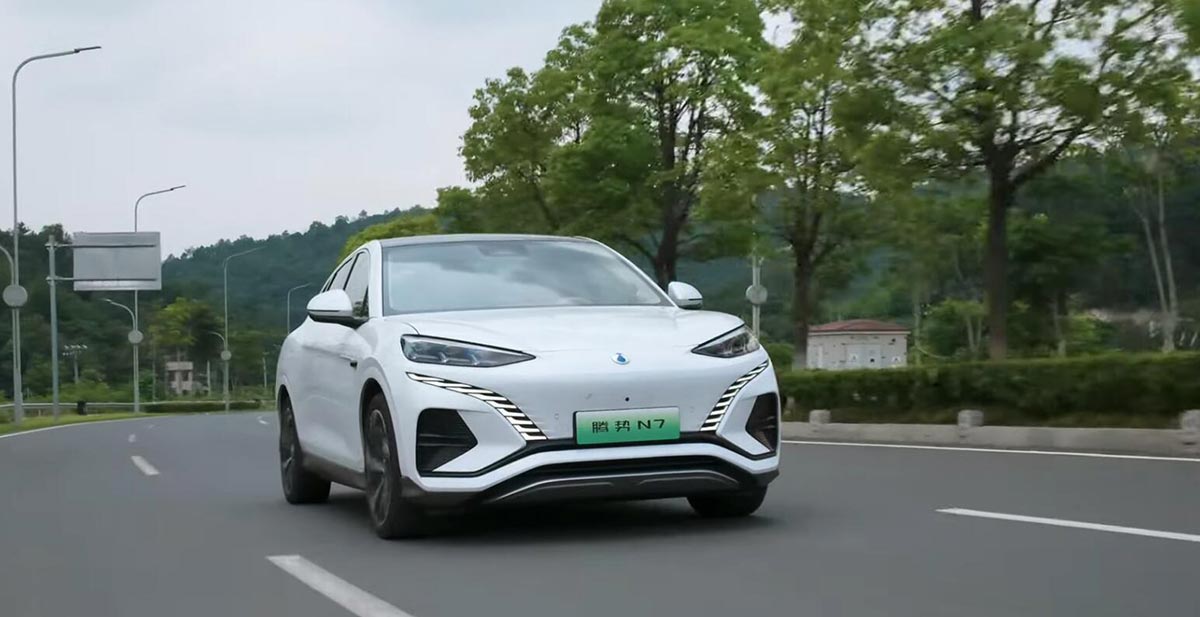The Denza N7 faces tough competition in its segment. Perhaps it can capture customers, especially with a traditional premium styling, it may find a market amongst a new older demographic.
This review is done by ChinaDriven, which creates content about Chinese EVs on YouTube & Twitter.

The Denza N7 is the latest premium crossover EV from BYD's premium brand Denza. Denza started as a 50/50 joint venture with Mercedes, but now with Mercedes owning just 10 percent, Denza has had a sort of soft relaunch with the Denza D9 MPV.
The Denza N7 is an important step for Denza, entering into the tough premium crossover NEV segment, which hosts heavyweights like the Nio ES6, Li L7 and plenty more. But the Denza N7 seems to have a slightly different direction.
Price
The Denza N7 single motor RWD costs roughly between $42,000-$44,500 in the Chinese domestic market, whilst the dual motor AWD will set customers back $45,000-$53,000. Since Denza is still trying to gain a foothold in China, there are no rumblings so far of export sales.
Battery, Range, Charging
Riding on a modified BYD e-Platform 3.0, all Denza N7s are equipped with the same 91.3-kWh LFP Blade battery pack. Denza claims that for the RWD models, the range is up to 702km, whilst the AWD models naturally have a shorter range at 630km.
Denza also claims advances in battery cooling & battery management leading to those range estimates. As well as cell-to-body tech (structural battery pack), which BYD first introduced for the BYD Seal.
DC fast charging in the Denza N7 is a unique experience. Many other companies are touting high peak charge times & rates, whilst Denza is doing something a little differently, and arguably something that might cause disagreement at the charging station.
Denza N7 is equipped with two DC fast charging sockets, allowing you to plug in two charging guns. The single gun mode will give you up to 150kW, whilst adding a second will result in the Denza N7 being able to draw up to 230kW. With the dual gun charging, the Denza N7 claims 350km in 15 minutes, or 100km in 4 minutes.

Exterior

The exterior has been somewhat of a sticking point for many online. Whilst overall the low-slung SUV silhouette is quite sporty, and from some angles like the rear 3/4s it looks downright decent. Many have expressed their distaste for daylight running lights (DRLs).
They are not the most beautiful design element, but they do bring something distinctive in the front end, separating it from the sea of slit DRLs & light bars.
The DRLs somewhat grow on you…but they are tough to love. Shame because the side profile and rear of this car have all the hallmarks of a well-designed crossover.
The side has a nicer profile, the window giving it a very fastback feeling design, coupled with the roof line falling at the rear pillar into the rear. Creases and folds around the car are well executed, the straight, rising bone-line, the pinched lower side adding style.
Trunk space in the Denza N7 is quoted at 480L with the seats up and 1200L with the rear seats down. That's not class-leading, but it's still a reasonable and usable size. The sacrifice of rear trunk space is passed on to the rear passenger room. The Denza N7 also has a decently sized 73L frunk.
Denza also provides a multi-plug extension cord which you can plug into the car charging socket for 6kW of V2L output, as well as a 2.2kW three-pin socket in the trunk.

Interior

The interior is something that gave me food for thought in the Denza N7. Initially, I was somewhat surprised, it doesn't follow the rest of the Chinese premium EV crowd with a futuristic, minimalist interior. It's far more warm, with plenty of European Poplar wood, metal accents, and silver plastics.
It's a well-designed interior, and I came to the conclusion that it might resonate with an underserved demographic in the EV market, the older gentlemen.
The interior design is modern, but it is also a far more traditional & classical approach to what “premium” interior design is. You'll find capacitive touch buttons etched into the wood panels, and supporting screens elegantly enveloped by Poplar wood, the dominating material feature. I found myself to be a big fan of it when I handed over the keys.
It's not lacking in features even if it's taken a turn toward the older generation. You'll find a 17.3-inch 2K touchscreen center stage, with a 10.21-inch digital instrument panel & and mirrored 10.25-inch passenger entertainment screen, making this cabin a mirror image means easy RHD production in the future perhaps.
There's 5G connection, dual 50W wireless chargers, a huge HUD, a fragrance system and a 16-speaker Devialet spatial audio system.
The rear is spacious, with plenty of legroom, headroom, and foot room. The rear seats are equipped with 2-stage heating and 3 recline positions. On a functional note, if you want to recline the seats, you have to use the same lever you used to fold the seats down, it's not the most sophisticated experience.
However, with the laid back, it's a comfortable place to be, with lots of light with the huge panoramic roof that comes equipped with an electronic sunshade.

ADAS
The Denza N7 marks a turn in the road for BYD advance ADAS. Both in terms of software and hardware. Our pre-production test car had no functional ADAS, but all Denza N7 will ship with a level 2 system, almost certainly a rebranded Di-pilot system. Nothing special.
But the Denza N7 is the first BYD product equipped with LiDAR, in fact, the two bumper-mounted lidar units are optional along with an upgrade ADAS Chip, Nvida Orin-X, but will be probably needed for advanced ADAS.
On the Denza N7 option list, you'll find City & Highway NOA as well. Meaning the Denza N7 will mark the beginning of BYD's jump into advanced ADAS systems. The Denza N7 is touted to have Highway NOA available by the end of 2023, with City NOA starting next year.
Driving

The Denza N7 is available in two powertrain options. The RWD single motor version has 230 kW & 360 Nm, good for a 6.8 s acceleration to 100 kph. The AWD dual motor version possesses 390 kW & 670 Nm, propelling it to 100 kph in 3.9 s.
The acceleration in the AWD model although quick is not a brutal affair. The torque delivery is not as linear as some other EVs, resulting in a smoother & more comfortable acceleration ramp.
Equipped with double wishbone up front and 5-link independent suspension in the rear, the Denza N7 is the first BYD product with it's new ”Di-Sus” air suspension. Air suspension as become almost a standard at this price point in China.
The new air suspension left me in two minds. Over harsh sharp bumps, like small speed bumps the Denza N7 air suspension rounded off the thumps nicely. However, on a seemingly smooth road a lot of small vibrations were passed into the cabin.
I must caveat that by explaining we were testing a pre-production model, so not everything is the exact final product. And the exact car we were driving had been used an abused by journalists on the media track and drift event. So it's not had the easiest life.
However, Denza has already expressed plans for OTAs this year for improved suspension & air suspension behavior. So hopefully if this is true of customer vehicles, it will be fixed with that OTA.
And yes, Denza has included a drift mode in an SUV. I'm not sure why, I assume it's part of Denza's claimed “sporty” nature of the Denza N7. I don't think I can call the Denza N7 sporty, but it is a comfortable & quick, except for the vibrations, long-distance cruiser.
Conclusion
The Denza N7 faces tough competition in its segment. And going from producing mass-market cheaper vehicles to ”rejuvenating” their lackluster premium brand is going to be a difficult task.
The Denza D9 MPV however, has been a massive hit in its segment, emerging as a new sign of stealth wealth in China.
So perhaps the Denza N7 can capture customers, especially with its traditional premium styling, it may find a market amongst a new older demographic.



